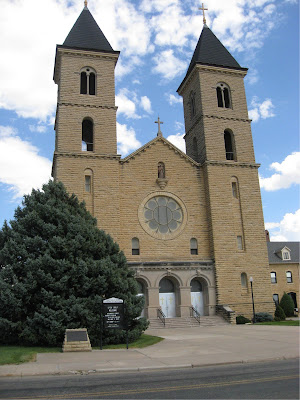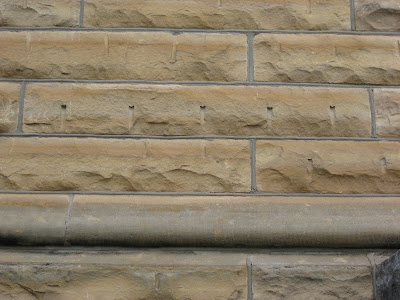It was established in 2005 and banners hang proclaiming awards for their beer-making in 2007, 2008, 2009. (I'm sure this will be a hoppin' place when the college students return to Ft. Hays!) We're not beer drinkers, but love good food. What a GREAT place to eat! Ellen and I had salmon burgers, she with asparagus and I with sweet potato fries. The guys enjoyed schnitzelwich, and for dessert we had a very decadently delicious French toast brulee which the four of us shared. I think I was too hungry to take any photos. Just take our word for it, it will be worth a two-hour drive just to go there to eat again!
Our next stop was the St. Fidelis Catholic Church, or the "The Cathedral of the Plains", in Victoria, KS. In 2008, it was named one of the "8 Wonders of Kansas", and it truly is.

The story of this church is too long to go into here but I'll try to summarize it.
The first settlers to the area were gentlemen farmers from England who settled in 1873 with the intention of duplicating their aristrocratic lives in spite of harsh weather and rough ground. They named their village Victoria after their queen and laid out the streets according to the plan of a London architect.
In 1875 they were joined by a group of poor immigrants from southern Russia known as Volga-Germans, who were fleeing from service in the Czar's army and dangers to their Catholic faith. They created a village of sod huts adjacent to Victoria and named it Herzog after their town in Southern Russia.
The British soon found pioneer life too extreme in contrast to what they were accustomed to in England and since they and the land could not adapt most returned home in a few years. The only thing that remained as a memorial to their efforts was the town name. The town was left in the care of the Volga-Germans who stayed to work the land and make it home. They kept the town's name Victoria.
Nothing was more important to these Germans than their faith and so they erected a cross in the center of town where they would go to pray. But life was incomplete without a church or a permanent pastor. Over time they built three churches, the first two of which they outgrew and then at the turn of the century (1908) they began construction of the current building. It was completed in 1911 and seats 1,100.

The stained glass windows are incredible!





The altar and pulpit were cut and hand polished in Italy. The paint colors are the original rich mauve, rose and gold tones.

This cross measures 5'x7' and is made of woven wheat.

There are 18 granite pillars which were brought to the site from Vermont. When they arrived, they were unloaded by the railroad 3/4 mile from the construction site. It took 8 horses to pull the 10-15 ton pillars and 40 men, each lifting from 40-70 pounds three times before they were ready to carry the rock into the church. The cost of the 18 pillars totaled $4,000!

The exterior is constructed of native limestone, quarried seven miles south of Victoria. Large layers of rock, about eight inches thick, were cleared of top soil and then perforated by hand augers with holes eight to ten inches apart. Wedges were inserted in these holes and tapped with a hammer until the rock sprang apart along the line of perforation. You can see the wedge lines in the long rock. The stone was then loaded on wagons and hauled to the building site. Each stone weighed 50-100 pounds. It is estimated that the people hauled and dressed more than 125,000 cubic feet of rock! Each parishioner was required to haul six wagon loads of stone from the quarries, and fathers and grown sons of some families are recorded as hauling as many as 70-80 loads of stone. Amazing!!! No modern technologies - block and tackle was used - no automatic lifts or power tools!!

This congregation is led by the Capuchin Franciscan Friars.
Willian Jennings Bryan, during his 1912 presidential campaign tour of the U.S., visited Victoria and was so impressed with the church that he named it the "Cathedral of the Plains". It truly is an amazing building with a rich history.
Carey and Nancy - thanks for recommending that we visit this place. Totally enjoyed it!
We watched the clouds build up all day. When we left Victoria it was 104 degrees, but in a few miles huge raindrops began to fall, as did the temp. It got down to 79 degrees! That did a lot to help the "heat psyche"! By the time we stopped for gas in McPherson, the rain stopped and the temp was back up to 94 by the time we reached home.



It was a great day! Thanks Ellen and LeeRoy for joining us!

I used to go to Hays quite a bit for work through mid-2008 (when our son was born) -- I've stayed there many a nights. It's too bad I hadn't ever come across that restaurant. I'm amazed you could get asparagus and sweet potato fries in Hays, but I'm glad you found it. Also, I have stopped (on work trips, actually) at the cathedral in Victoria, KS. I LOVE that cathedral. It is sooooo beautiful. I'm glad you guys got to do that. Happy Belated Birthday, Rich!
ReplyDeleteWhat a wonderful trip! I love doing that kind of thing too. Hint, hint, anyone! We stopped at Victoria with the youth group when our kids were that age. Didn't intend to - our van had a flat! We ate at a restaurant there but can't recall the name. You missed the storm that hit McPherson! Did you hear about it??
ReplyDeleteWow - you should write a travel digest or something. You write very informative blogs. I enjoy your writing a bunch. Thanks for sharing.
ReplyDelete